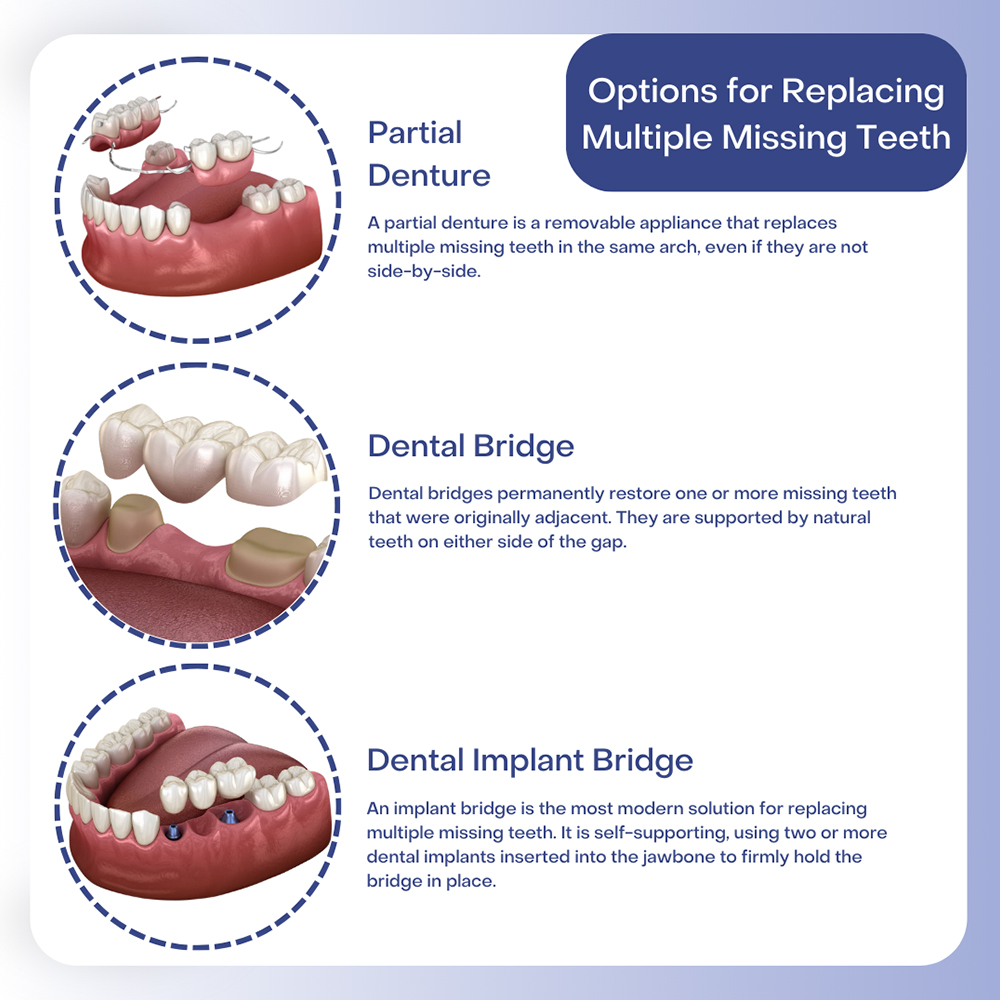Table of contents
If you are missing multiple teeth or have several teeth that are failing, you will almost certainly be interested in replacing them quickly.
Losing several teeth can impact your dental health in several ways:
There are three main options for replacing missing multiple teeth and include:

A partial denture is a removable appliance that can replace multiple missing teeth in the same arch. These missing teeth don’t need to have been side by side but can be located anywhere in the arch. If you have teeth that are likely to fail in the future, it may be possible to add these to an existing partial denture, provided it is still in good condition.
The denture has a gum-colored acrylic base and a lightweight metal framework usually made from cobalt chrome to provide adequate strength without adding too much weight or bulk. Denture implants are attached to the acrylic. There are metal clasps that fit around natural teeth.
Some partial dentures have special attachments. These are special fitments that are made to slot into corresponding fitments in crowns that have been cemented over natural teeth. Special attachments help hold a partial denture more securely in position.
Some partial dentures are made from a gum-colored nylon material that is flexible and very comfortable to wear. The clasps around natural teeth are also made from the same gum-colored nylon. The effect is discreet, but these partial dentures only suit certain circumstances and can lack strength and stability because they are flexible. Otherwise, an ordinary partial denture’s additional strength and structure may be better.
Potential advantages of choosing a partial denture can include:
Potential disadvantages of choosing a partial denture can include:
Dental bridges are a popular way to restore one or more missing teeth that were originally side-by-side. A dental bridge is permanently cemented in place and is supported by natural teeth.
Generally, the bridge is supported by teeth on either side of the gap. The teeth adjacent to the gap, called abutment teeth, are carefully shaped by the dentist, removing enough tooth structure to create crowns that look comfortable and natural and not too big and bulky.
These abutment crowns are attached to replacement teeth. Each replacement tooth is called a pontic and is custom-made to look natural. It rests directly on the gums, getting rid of the gap completely.
A dental bridge can be made from several materials, but the most modern are all-ceramic and made from a very strong material called zirconia. Because they are metal-free, they look very natural and are extremely strong. Zirconia is suitable for restoring teeth anywhere in the mouth.
Potential advantages of choosing a dental bridge include:
Potential disadvantages of choosing a dental bridge include:
An implant bridge is the most modern way to replace missing multiple teeth. It is self-supporting, using two or more implants inserted into the jaw to hold the bridge firmly.
Dental implants are inserted into the jawbone at strategic intervals during a short surgical procedure. The implants fuse with the surrounding bone so they are strong enough to support multiple missing teeth.
An implant bridge has crowns that fit over the dental implants, and these crowns support the replacement teeth called pontics. The implant bridge is cemented or, more likely, screwed onto the implants permanently. Implant bridges can be made from similar materials to ordinary bridges, including zirconia.
Potential pros of choosing a dental implant bridge include:
Potential cons of choosing a dental implant bridge include the following:
The cost can vary considerably. It depends on the number of teeth replaced and the method selected. The lowest-cost solution is a partial denture; the most expensive is an implant bridge. However, in the longer term, dental implants can significantly benefit dental health and give patients teeth that look and feel as natural as possible.
If you want to learn more about how to fix missing teeth, contact our dental center in New Jersey. We can assess your mouth, discuss your desires for treatment, determine how best to replace missing teeth and prepare your personal treatment plan. Our dentist will talk you through all solutions available, assisting you in making an informed choice.

My name is Victoria Kushensky. I am a general dentist dedicated to remaining at the forefront of my field. Combining compassionate care with extensive knowledge, I offer cosmetic and general dentistry services as well as advanced root canal treatments.
I earned my Doctor of Dental Surgery (DDS) degree from the esteemed New York University College of Dentistry. Throughout my career, I have honed my skills in various dental procedures, ensuring effective treatment for each patient’s unique needs. I prioritize patient comfort and understanding, taking the time to thoroughly explain procedures and address any questions.
More about Dr. KushenskyMy NJ Dentist: Victoria Kushensky, DDS
385 Prospect Ave Suite 304
Hackensack, NJ 07601
(201) 298-8000